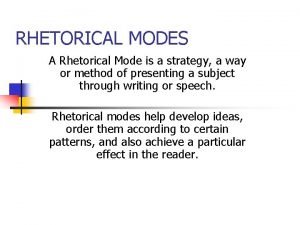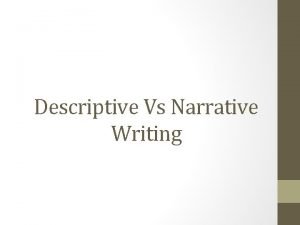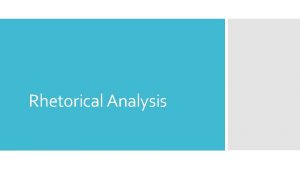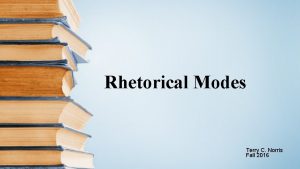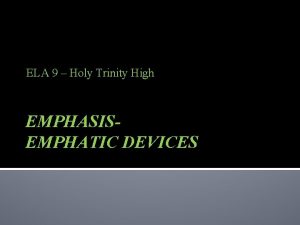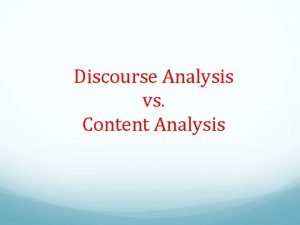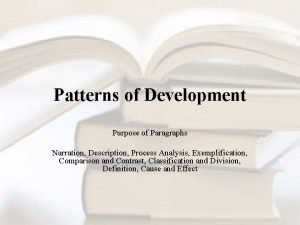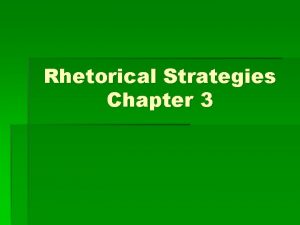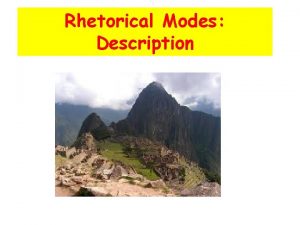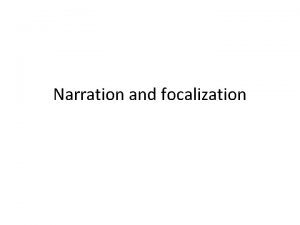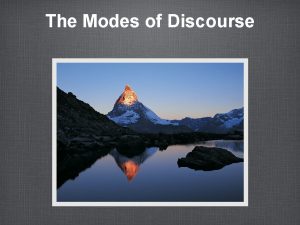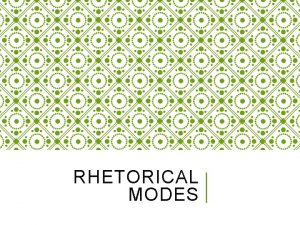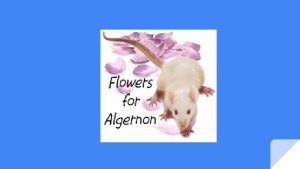Rhetorical Analysis Modes of Discourse Exposition Narration Description












- Slides: 12

Rhetorical Analysis

Modes of Discourse Exposition Narration Description Argumentation

Rhetorical Strategies Example Contrast/Comparison Cause and Effect Classification Process Definition Narration Description

EXAMPLE Specific event, person, detail of an idea cited or developed to support or illustrate a topic

CONTRAST/ COMPARISON Presenting similarities and differences between or among at least two persons, places, ideas, events, etc. Can be organized many different ways: Subject by Subject Point by Point Combination

CAUSE & EFFECT Establishes a relationship: B is the result of A. Developed using Facts Statistics Authorities Anecdotes Cases Real or imagined scenarios

CLASSIFICATION Separates items into major categories and details the characteristics of each group and why each member of that group is placed within the category

PROCESS How to do something or how something is done Can be instructional or simply informative Must be chronological Defines necessary terms and cites precautions where needed

DEFINITION Identifies the class to which a specific term belongs and those characteristics which make it different from all other items in the class. Several types of definitions: Physical Historical Emotional Psychological Relationships to others

Telling a story NARRATION 1 st person 2 nd person 3 rd person omniscient 3 rd person objective Stream of consciousness

Description Can be objective (scientific or clinical) Can be impressionistic (tries to involve emotions or feelings) Can employ literary devices: Analogy Concrete, specific words Appeal to the senses (imagery) Personification Hyperbole Contrast and comparison Onomatopoeia Other Figurative language

Description (cont. ) Can be organized as follows: Chronological Spatial Emphasizing the most important detail Emphasizing the most noticeable detail
 Ano ang mode of discourse
Ano ang mode of discourse Rhetorical modes meaning
Rhetorical modes meaning Rhetorical modes definition
Rhetorical modes definition Descriptive narrative
Descriptive narrative What is discourse
What is discourse Exposition rhetorical mode
Exposition rhetorical mode Rhetorical discourse
Rhetorical discourse Define rhetorical modes
Define rhetorical modes Rhetorical trinity
Rhetorical trinity Discourse analysis vs content analysis
Discourse analysis vs content analysis Classification pattern of development
Classification pattern of development Rhetorical strategy description
Rhetorical strategy description The role of context in interpretation slideshare
The role of context in interpretation slideshare


